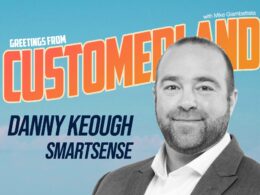Customer-led growth is all about “looking to your customers first to figure out what growth levers you should use”
It’s hard to work in marketing, or anything else, without frequent discussions of “the funnel” — a common, visual way to represent the customer journey. Its layers represent stages from awareness to purchase; it’s width represents the number of prospects in each stage. It tapers because, inevitably, some people will hear about your product but not buy it. (Unlike a literal funnel, it’s leaky.)
Maybe it’s time to forget the marketing funnel.
Especially in tech, the funnel is a controversial concept. Perhaps the customer journey really looks more like a flywheel. Maybe it shouldn’t be sliced into layers owned by different departments, but instead treated as a cohesive whole, ruled by a few North Star metrics. Maybe the funnel needs additional layers, representing the customer journey after a purchase — like loyalty, or retention and referral.
Georgiana Laudi’s critique of the funnel is more existential.
“It’s just not very customer-centric,” she told Built In.
The funnel presents the customer journey in terms of the business’ goals. It’s “complete” when the customer behaves in a way the company wants them to — by making a purchase or, in certain revised funnels, by becoming an enthusiastic regular. This is all wrong, in Laudi’s opinion. It “incentivize[s] transactional moments … and they’re not about driving customer value.”
She argues that, instead, the customer journey should be framed in terms of the customer’s goals. This might seem like a cosmetic tweak to the original funnel, but in Laudi’s experience, it’s not. In a previous marketing role at landing page provider Unbounce, she was barely scraping by until she remapped the customer journey in terms of customer value — inspired by a visit to Airbnb headquarters.
Over the next two years, the company grew its revenue by nearly 900 percent.
“Gaining clarity on — and operationalizing how — our best customers received value, and achieved their goals, led us to reach ours,” she wrote of the experience. Now she teaches other SaaS marketers to follow a similar strategy at an education hub called Forget the Funnel, which she co-founded with Claire Suellentrop. They call their approach customer-led growth.
THE OPPOSITE OF ‘WE NEED MORE LEADS!’
It sounds like a competitor to another popular growth strategy in the tech sector: product-led growth. The two aren’t mutually exclusive though. Customer-led growth is all about “looking to your customers first to figure out what growth levers you should use,” Laudi said.
You might decide to adopt a product-led growth strategy — but if you arrive at it through a customer-led growth strategy, you’re not adopting it because it worked so well for Slack, or because it’s a ubiquitous industry buzzword. You’re doing it because it serves your customers.
That sounds simple, but it was counterintuitive to the steady stream of tech founders Laudi encountered as a consultant. Over and over, they told Laudi, “We just needed more leads.”
Usually, they didn’t. They needed a better customer experience: more streamlined onboarding, or easier-to-access moments of value. Many also had issues with positioning — communicating their product’s unique value proposition in a clear, concise way — which meant they were acquiring customers who weren’t a good fit.
“There’s no point in driving more leads if you’re literally leaving money on the table post-acquisition,” Laudi said. These founders didn’t need leads, the type of transactional KPI customer-led growth was designed to discourage. They needed a deeper understanding of their customers. They needed to think like marketers.
CUSTOMER-LED GROWTH WORKS ESPECIALLY WELL FOR…
- Companies selling SaaS products.
- Companies that already have established, loyal customers and “momentum.”
- Companies considering product expansion.
The founders rarely saw it that way. In tech, growth and data reign; industry leaders often conflate marketing with advertising and wasting money. Laudi says several marketers have emailed her about feeling so undervalued that they cry in the bathroom at work.
But oddly, tech companies — especially SaaS companies — need marketing more than many other companies. A subscription model means they essentially need to re-acquire all their customers monthly.
Laudi and Suellentrop help SaaS founders do that.
HOW TO IMPLEMENT A CUSTOMER-LED GROWTH STRATEGY
There’s no one-size fits all customer-led growth strategy, Laudi said. What works depends on who your customers are, what they want, and what “customer success milestones” show them your product’s unique value.
The idea of customer success milestones aren’t new, exactly — in the AARRR metrics, which Dave McClure first presented in 2007, the second A stands for “activation.” This typically means hitting some sort of usage milestone, often called an “aha! moment,” correlated with long-term loyalty. In the early days of Facebook, activation meant making seven friends in your first 10 days on the site.
If you really value your customers, you don’t shunt them through a sales funnel.
Customer-led growth expands on McClure’s idea of activation. Rather than restricting it to a single moment, Laudi thinks of activation as a series of moments throughout the customer journey. At Elevate, she and Suellentrop help clients identify these moments and nudge them closer together, through a constant, iterative cycle of research, mapping and action.
RESEARCHING
The process starts with gathering “customer insights,” Laudi explained. This doesn’t necessarily require hundreds of responses or months of digging. It can, and should, be a low-lift process companies go through regularly, because products and customers evolve.
Especially in a post-COVID world, “your customers were completely different last year than they are this year,” Laudi said.
She recommends surveying and spot-interviewing high-value customer segments, and asking big questions: What do they want to accomplish? At key forks in the road, what has motivated them to invest further in your product? What features hold most value for them?
MAPPING
Then it’s time to map the customer journey. Most break down into three broad stages, according to Laudi: feeling pain, evaluating solutions and exploring one solution. (Her shorthand: “pain, evaluation and growth.”)
The landmark moments along the way though — especially in the growth phase — depend on the product. To identify them, she leans on the jobs to be done framework; a customer success milestone is often a job, completed.
ACTING
Next, it’s time to turn the map into action, which usually means creating internal KPIs linked to customer success milestones and divvying them up among teams.
“You might have to use proxy metrics,” Laudi acknowledged. “But getting as close to the customer achieving some moment of value is what I would say the KPI should be.” Early customer-led growth KPIs are pretty universal: unique visitors to the company site, plus some indication of interest, like an email sign-up or a trial start.
As the customer journey progresses, KPIs become more product-specific. In general, though, Laudi advocates against focusing on metrics like trial sign-ups or credit card numbers entered. Instead, she tries to shift focus toward things like hitting key usage thresholds.
There’s rarely just one KPI in customer-led growth. “I’m not against North Star metrics,” Laudi said, but “you always need to be looking out for [all the] signs of a healthy customer.”
HOW TO AVOID CUSTOMER-LED GROWTH’S PITFALLS
The strategy isn’t foolproof, but Laudi has learned how to avoid its most common pitfalls over the years.
DON’T ASK CUSTOMERS WHAT THEY WANT
“If I asked people what they wanted, they’d have said faster horses.” This quote is commonly attributed to Henry Ford, creator of the Model T, and though he likely never said it, the idea is still sound, Laudi said. Customers are better at identifying problems than telling you what product to build.
So in an ideal research process, “you’re not asking [customers] for the solution,” she said. “You’re asking them to tell you what life was like … when they started seeking a solution.”
DON’T TRY TO PULL INSIGHTS FROM EVERY CUSTOMER…
Not all customers have equal leadership potential. Segmentation is key.
“Really narrow it down by the people who are getting a ton of continued value, have a high willingness to pay [and] are super, super happy with you,” she said. “If you can talk to enough of them … you can uncover patterns.”
…OR SOLVE EVERY CUSTOMER PROBLEM THAT EMERGES
That’s patterns, plural. You don’t have to solve every common customer problem though.
“You need to put blinders on to the vast majority and focus just on the group that you can solve for,” she said. That means figuring out which problems align with your organization’s strengths and capabilities, in terms of values, talent, bandwidth and back-end aspects of your product.
DON’T FOCUS ON WHAT YOUR PRODUCT COULD BE — FOCUS ON WHAT IT IS
Speaking of your product — it could become almost anything in the future, but it’s important to stay grounded in the present when prioritizing customers’ jobs to be done. Which ones can be knocked out quickly, given current resources? Which ones feel most relevant to what the company already does?
“It’s not just about the customers you want to solve for, but it’s also the customers that you can solve for,” Laudi said.
HOW CUSTOMER-LED GROWTH PAYS OFF
Most obviously, it pays off in growth. (Hence the name!) Companies get more paying customers, and more loyal paying customers, which means higher revenue and lower churn. It doesn’t just benefit customers and the company’s bottom line though — it also benefits employees.
“It’s like marketing internally,” Laudi said. Framing the company’s success as dependent on customer success creates a culture of service and purpose; framing success as a process of pushing customers through a funnel, creates a different, more extractive kind of culture.
“Words matter,” Laudi said. “Any mention of the customer experience map has a big impact on how your team is going to empathize … with your customers.”
This article originally appeared in BuiltIn. Photo by Jungwoo Hong on Unsplash..













